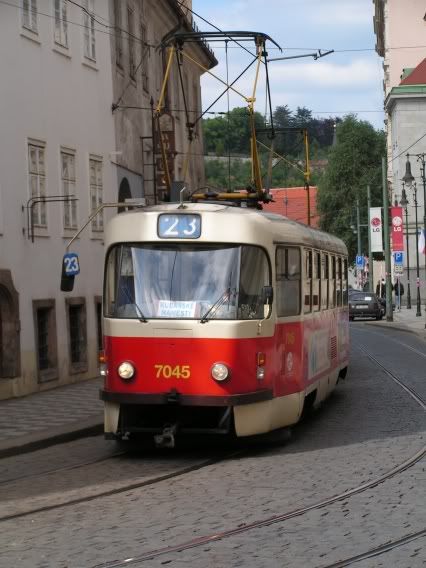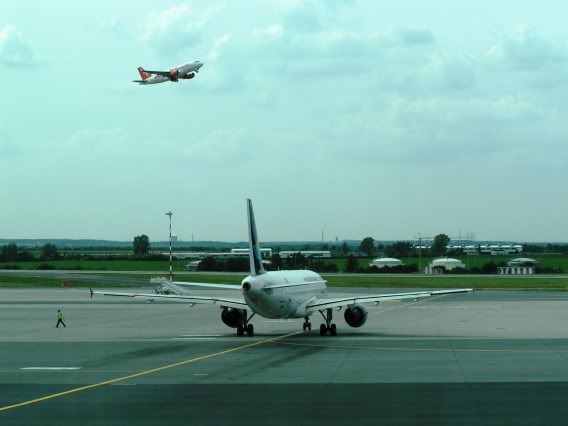Post by Deleted on Jun 8, 2006 21:50:01 GMT
In the last week I visited Prague for a few days, and managed to ride the whole metro system. The photos are on my Flickr photo site, linked to in my signature.
The system is of a typical Eastern Bloc 3 line design, with three interchange stations between the lines. Almost the whole system is underground, either in cut and cover, or (very!) deep level tunnels. The deep level stations are of a three arch design, as found on the Victoria and original Jubilee Line. There are sections of surface or elevated running, but the trains are still enclosed, one section being an a transparent tube! Only one section is open to the elements, and that is the new extension to Depo Hospivar on Line A. The system has recovered well after the 2002 floods where the water managed to reach half way up some of the escalator shafts!
There are three trains in use, all with 5-cars and approx 100m long. The generic Soviet 81-71 stock, which had quite impressive performance. The refurbished (by Skoda!) 81-71M, which is almost unrecognisable from the original 81-71. Plus the newly built M1 stock, with rather whiny VVVF motors. Interior layouts were quite spacious. All trains had very good auto-announcements, and digital displays (apart from 81-71 stock). A red warning light is lit above the doors a few seconds before the doors closed accompanied by a recorded announcement, but there were no door closing alarms.
Each line has a different signalling system. Line's A and B seemed to be manually driven with ATP, and run 2min30sec headways. The 81-71 stock on Line B seem to be driven quite aggressively, with station braking consisting of 3 heavy air brake applications! Line C uses a Matra/Siemens PA135 ATO system, as also found on the Paris Metro. Line C runs 1min55sec headways.
Onto my favourite subject of terminus operations. Of great interest was Ladvi, one of the termini of Line C. This is a two track terminus, with a scissors crossover, and manages to turn an impressive 31tph. I rode in and out of this terminus five times during the peak period, and the train never stopped or even significantly needed to slow down for the crossover's home signal. Quite a precision operation! This efficiency may be due to the Soviet style headway clocks at the station headwalls, which display the time since the last train departed. This helps drivers maintain even headways between the trains, in this case 1min55secs. The same system is also used for departing trains from the terminus, with the doors closing sequence being initiated at approx 1min40secs, and the train departing at 1min55secs. I was interested to see if drivers would close the doors if the starter signal was red due a late running inbound train, but during my observations the trains always arrived within 1min17secs to 1min25secs. Drivers stepped back at least two trains at this terminus.
At the other end of the line, and some other termini, the trains reverse in sidings. The trains are double ended (driver at both ends) for this procedure during the peak period, and the reversal usually takes approx 90secs. Trains dwelled for 30-40secs in the arrival platform, where the drivers stepped back at least two trains. At Skalka, a reversing point for 50% of Line A's trains, the trains actually reverse in the outbound platform instead of in a siding, yet without delaying the trains behind. Again, quite a precision operation.
Finally, the tickets were quite cheap, a 24 hour ticket (which is really valid for a whole 24hours from validation) cost approx £2, and was also valid on Buses and Trams.
The system is of a typical Eastern Bloc 3 line design, with three interchange stations between the lines. Almost the whole system is underground, either in cut and cover, or (very!) deep level tunnels. The deep level stations are of a three arch design, as found on the Victoria and original Jubilee Line. There are sections of surface or elevated running, but the trains are still enclosed, one section being an a transparent tube! Only one section is open to the elements, and that is the new extension to Depo Hospivar on Line A. The system has recovered well after the 2002 floods where the water managed to reach half way up some of the escalator shafts!
There are three trains in use, all with 5-cars and approx 100m long. The generic Soviet 81-71 stock, which had quite impressive performance. The refurbished (by Skoda!) 81-71M, which is almost unrecognisable from the original 81-71. Plus the newly built M1 stock, with rather whiny VVVF motors. Interior layouts were quite spacious. All trains had very good auto-announcements, and digital displays (apart from 81-71 stock). A red warning light is lit above the doors a few seconds before the doors closed accompanied by a recorded announcement, but there were no door closing alarms.
Each line has a different signalling system. Line's A and B seemed to be manually driven with ATP, and run 2min30sec headways. The 81-71 stock on Line B seem to be driven quite aggressively, with station braking consisting of 3 heavy air brake applications! Line C uses a Matra/Siemens PA135 ATO system, as also found on the Paris Metro. Line C runs 1min55sec headways.
Onto my favourite subject of terminus operations. Of great interest was Ladvi, one of the termini of Line C. This is a two track terminus, with a scissors crossover, and manages to turn an impressive 31tph. I rode in and out of this terminus five times during the peak period, and the train never stopped or even significantly needed to slow down for the crossover's home signal. Quite a precision operation! This efficiency may be due to the Soviet style headway clocks at the station headwalls, which display the time since the last train departed. This helps drivers maintain even headways between the trains, in this case 1min55secs. The same system is also used for departing trains from the terminus, with the doors closing sequence being initiated at approx 1min40secs, and the train departing at 1min55secs. I was interested to see if drivers would close the doors if the starter signal was red due a late running inbound train, but during my observations the trains always arrived within 1min17secs to 1min25secs. Drivers stepped back at least two trains at this terminus.
At the other end of the line, and some other termini, the trains reverse in sidings. The trains are double ended (driver at both ends) for this procedure during the peak period, and the reversal usually takes approx 90secs. Trains dwelled for 30-40secs in the arrival platform, where the drivers stepped back at least two trains. At Skalka, a reversing point for 50% of Line A's trains, the trains actually reverse in the outbound platform instead of in a siding, yet without delaying the trains behind. Again, quite a precision operation.
Finally, the tickets were quite cheap, a 24 hour ticket (which is really valid for a whole 24hours from validation) cost approx £2, and was also valid on Buses and Trams.



 )
)








 .
.





